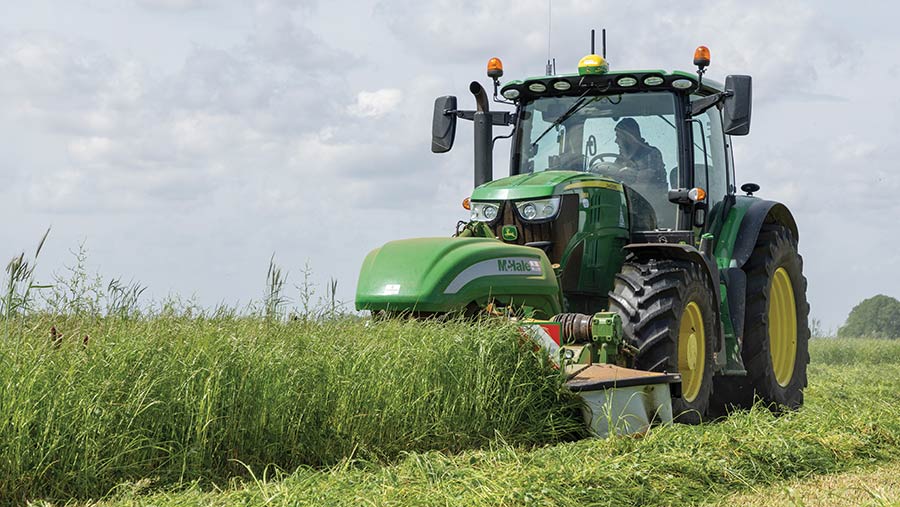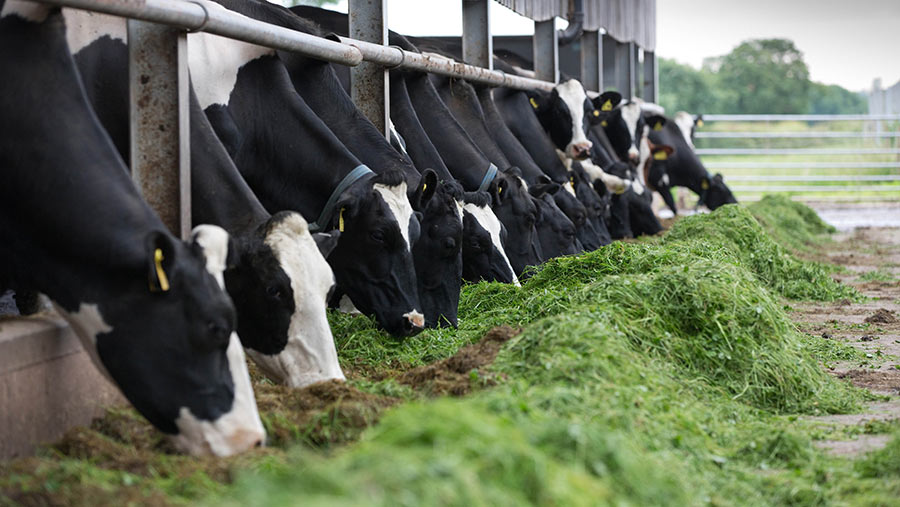Advice on sampling fresh grass for this season’s silage
 © GNP
© GNP A pre-cut grass sample, analysed for crude protein content and nitrate nitrogen levels, should be used as a gauge to time all silage cuts this season and review fertiliser inputs.
Taking a grass sample from a silage sward the same week as a planned cutting date is not about deciding on a specific mowing time.
Instead, silage specialist Dr Dave Davies says that the aim is to review sampling results as a good reflection of soil nutrient management and can thus inform future fertiliser plans.
“Monitoring fresh grass gives you more information about your soil fertility regime alongside what is happening in the field,” he says.
“That is because nitrogen (N) uptake by the grass plant is affected by N application rates and dates, fertiliser type, and weather conditions.
See also: 8 ways to produce award-winning silage
Testing fresh grass looks at the relationship between crude protein (CP) and nitrate in the plant, says Dave.
This is a more useful measure than sugar levels, which many people focus on, because sugar is respired by the plant in the fresh sample – some 50% of it can be lost on the way to the laboratory, he points out.
“It is not a true reading: sugars can change by 50% depending on whether you sample on a dull day versus a bright, sunny day.”
Fertiliser nitrogen
Instead, the fresh analysis can help work out whether too much fertiliser N or not enough has been applied to grow a crop of good-quality, leafy grass.
Together with reviewing the effects of extreme rainfall and flooding on fields and grass growth, it is possible to change fertiliser amounts or spreading intervals before subsequent silage cuts:
“You have got time, even in a multicut system, to add more fertiliser between cuts,” he says.
For a productive animal such as a milking cow or pregnant ewe (see “Benefits of making two types of silage”), Dave says the CP target should be at least 16% and ideally 18% in fresh grass.
A sample result of 17% CP and 0.15% nitrate N is about right.
“If you get 14% CP and 0.05% nitrate N, then you could have added more fertiliser nitrogen.
A 17% CP and 0.2% nitrate N means possibly too much fertiliser has been applied, or the grass has not grown and used the nutrients,” he explains.
Dave reckons few farms would see very high N levels in their grass samples.
But when it does happen, he recommends cutting anyway (rather than allowing the grass to grow, using up the nitrogen) and using a chemical additive to inhibit undesirable fermentation.
Nitrogen feeds grass
“If you are not at 17-18% CP and your nitrate is below 0.05%, this shows the nitrogen feed to the grass plant has run out before cutting.
“If the plant is stem and seedheads, this is all extra grass growth, and you should have cut the sward earlier. But if the grass is still leafy, you could have used more N fertiliser.”
It is important to work on a field-by-field basis because of the influence that excess rainfall can have on nutrient leaching from the soil profile:
“The other extreme could be with a cold, dry spring, [when] nitrogen sits in the soil not being used by the grass plant until the rain comes again,” he says.
It is also important to consider the ratio of N to sulphur (S). This should be 12:1, says Dave, yet UK grassland tends to be low in sulphur, which is needed to make protein.
Comparing fresh grass sample results year on year will keep fertiliser planning on track according to changing farm weather patterns.
“The cost of a sample, about £25, is peanuts compared to your fertiliser regime, or buying in protein concentrates.”
Benefits of making two types of silage
Most livestock farms should make two types of silage: one for dry or suckler cows, and one for milkers or growing stock.
A single clamp of silage will be nutritionally too good for dry cows and suckler cows yet will not feed growing animals to realise their genetic potential, according to silage specialist Dr Dave Davies.
The target for good quality is 17% crude protein (CP), 11.5MJ/kg metabolisable energy (ME) dry matter (DM) with a 72% digestibility value.
However, Dave says what usually happens is that dry cows and heifers are fed silage of poorer hygienic quality from the edge of a clamp.

© Tim Scrivener
This silage carries an increased risk of mycotoxins and pathogenic bacteria, such as listeria and clostridia, which can cause heath issues.
“The peripheral regions of a clamp are also nutritionally challenged because where silage conservation has not been good, a proportion of the organic matter has been lost,” he says.
This increases the ash content and, along with it, the mineral content:
“Increased mineral content raises the levels of things like potassium, causing increased health issues around calving,” he adds.
Selected dry cow field
Cutting and clamping grass specifically for dry cows means selecting a field where no muck or slurry is to be applied, only nitrogen fertiliser. This will reduce potassium levels.
“Pick a field to do it and make it a long-term, dry-cow silage field. You won’t need to change grass varieties – you still want a productive grass so you can reduce potassium levels,” he says.
“The aim here is to feed the cow, not the grass plant. Go for an eight- to nine-week cutting interval and the grass will be long and stemmy – up to 35-40% DM if you bale it and 30-35% for grass that is clamped.”
This crop should be well preserved, and an additive could help reduce undesirable microflora to maintain a high hygiene level.
“You will get a 10ME and 12% CP silage that will be suitable for suckler cows as well,” he adds, pointing out that the effort of making two silages needs to be weighed against the cost of bought-in feed that might otherwise be needed.
Nutritionist David Wilde, national ruminant technical manager for Massey Feeds, says he agrees with the concept of making a separate silage.
However, a separate, dedicated dry-cow clamp may not be practical on most farms.
Large herds of 500-plus dairy cows might have the numbers of dry cows to justify the cost, otherwise he says big bales will suffice.
The extra cost of bales will pay dividends in cow health, David points out.
Low energy, high fibre
“The point is to maintain a lower energy supply in the first five weeks of the dry period.
A dry [forage with] high neutral detergent fibre, low potassium and low phosphorus will give gut fill and maintain rumen fill scores at 4-5.
“There is a wealth of evidence there is far too much phosphorus in diets, which predisposes to milk fever,” he says.
This fibrous forage could also remove the need for chopped straw to dilute the ration energy and supply bulk, or the rate of inclusion could be dropped from 4kg a head to 1kg a head.
“Then, in the final two to three weeks, add in a secondary forage – maize or wholecrop, as being fed to the milkers – and 2kg of dry cow supplement.”
